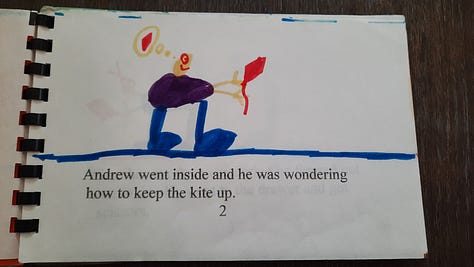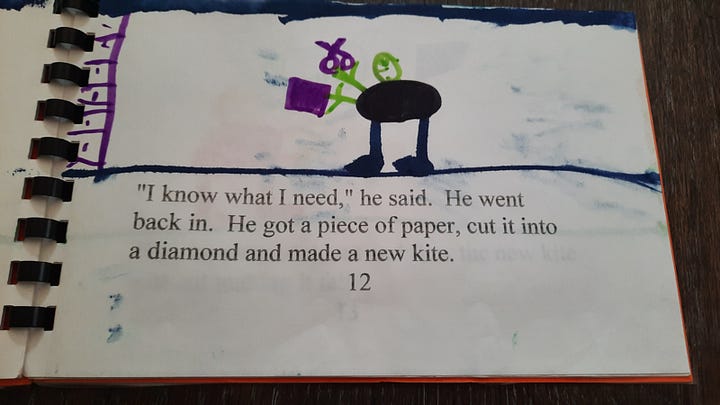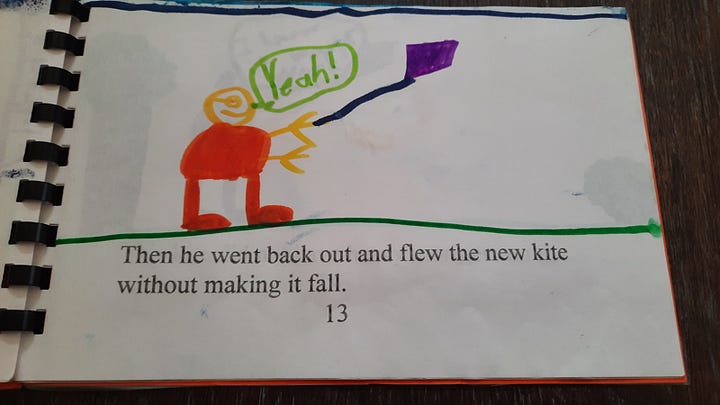Astrology is Real: Part 3
The Rong Kite
Why do children do things? How much do they understand that goes by unnoticed from the eye of the adults?
In this post, we will journey through a story I wrote in 1st Grade and observe some patterns. I have a wonderfully thoughtful mother who stored my many elementary school creations and report cards in a cardboard box in the attic, which thankfully allowed me to re-discover this story as an adult. I found this story you are about to read within the last year, which is after I had noticed the connections from Part 2. If you haven’t read Parts 1 and 2, you should do that first:
Part 1 - wherein I describe the astrological archetypes of my “Big 3”.
Part 2 - wherein I tell an experience I had in Kindergarten, describe how it shaped my later years, and analyze this progression in terms of my astrological archetypes.
interlude - wherein I provide some supplemental materials to emphasize the vibes of each archetype.
After you’re all caught up, read on.
The Rong Kite
I wrote this story in May 1997, near the end of my first grade year. I was seven years old. Look, it was even good enough to win me a prize.
The [W]Rong Kite tells the story of my friend and schoolmate Andrew, the same Andrew I was wrestling with in Kindergarten from Part 2. In this story Andrew tries to fly a kite and has a bit of trouble. He tries many solutions to get his kite to fly. I’ve included photos of each page of the book so you can follow along1.






Andrew is flying his kite with a red monster on it when a mysterious force causes it to fall down [1]. He can’t seem to get it back up again, so he goes inside to experiment with some solutions [2,3]. He first tries to cut the wings off of the kite to make it lighter but this doesn’t work; he is dragged away [4,5].





Andrew tries two new solutions: putting bows on the kite [7,8,9], and making the kite a different color by coloring it with markers [10,11]. Neither of these solutions make the kite fly.




In our final four pages, Andrew finds his solution. He goes back to his workshop and makes a completely new kite [12]. This kite flies without falling [13], and Andrew is happy [15]. What is it about this new kite that allowed it to fly?
…
…
…
…
…
This kite did not have heavy monsters on it.
…
…
…
…
…
If I were reading this story aloud, I would let the silence hang for a moment so this ending could sink in. This kite did not have heavy monsters on it. Is it just me or is this a creative re-telling of my exact Kindergarten experience?
Andrew and I were wrestling in class. We both got in trouble. It affected me differently than him so that we behaved differently in school (with that 6th grade music class as an example). I wrote this story in first grade, the year after Kindergarten. Was the monster a symbol of him getting in trouble during class?
Returning to the astrological metaphor, the “monster” is my true Aries nature (restless, impulsive, headstrong) that got in trouble for wrestling. In The Rong Kite, Andrew doesn’t get his kite to fly until he makes a totally new kite that “doesn’t have heavy monsters on it”. He has to craft a new persona to ascend. Remember that Gemini is an air sign (air is how kites fly), and is associated with the mind. The young author took that bold aggressive fire that wanted to wrestle and forced it inwards. He adapted to his circumstances and used his clever little mind to mythologize his story onto the page and win first prize in the 1st Grade book reading.
It is not horseplay or the roughness of male competition as such that makes him turn away, but the utterly fake or artificial character of such displays, usually, in our time. Such boy perceives what his peers don’t, the conditional and entirely dependent character of life in our age. It is not the masculinity, the competition for status among men, the physical roughness, that makes him turn away… but the fact that all such play is happening in already owned space.
This precocious young child sensed that he was already in owned space and stifled that monstrous part of himself, and instead channeled his fire into a more acceptable form of expression: writing a story.
What was going through the young author’s mind when he wrote this story? Was he conscious of the underlying symbolism? Or was his mind merely channeling deep psychological perceptions of his environment, unaware of its deeper meaning?
I see many of the astrological themes from Parts 1 and 2 interwoven thru this story, as shown in this below table:
The most beautiful part of this story is that he never threw away the old kite.
Sure, he tried to modify it by cutting off its tail, putting bows on it, or coloring it with markers; but he never threw it away.
He took that Rong Kite with the monster on it and stored it somewhere deep in the corner of his basement.
For years he used his new and improved kite to fly as high as he could. That kite helped him to learn to read and write, to count and add and do math, to understand science and history.
He soared and soared and soared, but he still missed his old kite. As he got higher and higher, he earned more freedom and more opportunities. And eventually he used that freedom to destroy his loyal kite (and his liver) with cheap beer and shitty vodka.
When that loyal kite was weighed down with all those brain-killing chemicals, he had no other option but to descend deep into the basement where he had stored that old kite many many years ago. He would pick up that old kite with the monster on it, blow off the dust, carry it upstairs to the clear blue sky, wrap the string around his hand, and let it fly once more.
If you want to read the original story as one continuous piece, I’ve combined them in an imgur album (sorry about the ads).





